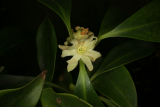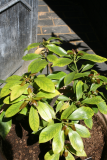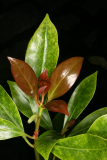Additional notes (click to expand)
Medicinal
Viral neuraminidase inhibitor
The seed capsules (star anise)contain shikimic acid, from which oseltamivir (Tamiflu) was synthesised, for treating bird flu, swine flu and influenza A & B.
Oakeley, Dr. H.F. (2013). Medicines from RCP plants label list 5-2013.docx.
Star Anise. The fruits, traditionally used as an insecticidal fumigant and expectorant, are now a source of shikimic acid for Tamiflu.
Nomenclature
Illicium from the Latin for Allurement, referring to the aromatic scent
Stearn, W.T.. (1996). Dictionary of Plant Names for Gardeners. Cassell.
Other use
Unripe fruit a culinary spice, especially in liqueurs
Mabberley, D.J. (1997) The Plant Book, ed.2, Cambridge University Press p. 361
Illicium verum Hook.f. Illiciaceae Chinese Star Anise Distribution: China. Illicium anisatum Japanese Star Anise. Distribution Japan. Illicium verum is used as a spice in Asian cooking and for Star Anise tea. The distilled oil is added to cough mixture used by children. Introduced to Europe in 1588 (Pharmacographia Indica, 1890). Illicium anisatum syn. religiosum, has been confused with it (Lindley, 1838, Bentley 1861) but is poisonous and was used to make incense in Japanese and Chinese temples. It was called Skimi by Kaempfer. The seed pods of both species contain shikimic acid (the name being derived from the Japanese word for the plant - shi-kimi) from which Tamiflu, the antiviral drug was synthesised.
Oakeley, Dr. Henry F. (2013). Wellcome Library notes.
link
Notes by Henry Oakeley from Lindley's 'Flora Medica' (1838): Chinese star anise, ‘from the provinces of China, west of Canton’, has fruits which on heating and distilling produced an oil similar to oil of anise (also called aniseed, Pimpinella anisum), which, Lindley notes, was substituted for the latter in the production of liqueurs. The Chinese used it in cooking as a carminative (to prevent flatulence) and stomachic and as a spice in cooking. It is a major ingredient in the Indian dish Garam Masala. At the College it grows in the oriental beds near the path to the rear entrance of the College.
Lindley, John. (1838). Flora Medica, Longman, Orme, Brown, Green & Longmans
Illicium verum, Chinese star anise, a culinary spice also used to make star anise tea. Illicium seed pods (mostly from I. verum) contain shikimic acid from which ‘Tamiflu’ (oseltamivir), a treatment for bird and swine flu, is made. Neither extracts from the plants nor shikimic acid itself have any effect as antiviral agents. These plants are also the source of an anti-cancer treatment that is an angioneogenesis inhibitor (ie it stops the production of the blood supply to the tumour). This property is also used to prevent the little tubes, the ‘stents’ that are used to open up blocked coronary arteries, from clogging up. The stent is impregnated with the chemical and this leaches out slowly, acting like anti-fouling paint and so preventing the coronary artery lining from growing inside the stent.
Oakeley, Dr. Henry. (2011). A Year in the Medicinal Garden of the Royal College of Physicians, revised edition. Royal College of Physicians, London. page 35
link
see Toxicity box for warning about misidentification.
Toxicity
Contains Trans-anethole, an alkenylbenzene, is carcinogenic, not genotoxic. Increased hepatocellular carcinoma secondary to hepatotoxicity in female rats over two year period.
Contains estragole and methyleugenol, which are in the alkylbenzene group. They are carcinogenic and genotoxic in rodents.
van den Berg, S.J.P.L., Restani, et al., P.. (2011). Levels of Genotoxic and Carcinogenic Compounds in Plant Food Supplements and Associated Risk Assessment. Food and Nutrition Science 2: 989-1010. p. 994
link
Not to be confused with Japanese Star Anise, Illicium anisatum a highly poisonous plant, used as an incense in Japan, ingestion of which damages the nervous system, kidneys and intestines and causes fatalities.
Note by Henry Oakeley
Illicium verum Hook.f.
Family: SCHISANDRACEAEGenus: Illicium
Species: verum Hook.f.
Common names: Star Anise; Chinese Anise
Distribution summary: China, Vietnam
Habit: Shrub
Garden status: Not currently grown
Reason for growing: Medicinal




